Intel Core i7 4960X (Ivy Bridge E) Review
by Anand Lal Shimpi on September 3, 2013 4:10 AM EST- Posted in
- CPUs
- Intel
- Ivy Bridge
- Ivy Bridge-E
Visual Studio Compile
Our compile test is back and better than ever. With a much larger and faster SSD (Samsung SSD 830, 512GB), we're able to get more consistent compile times between runs. We're now using Visual Studio 2012 to compile Mozilla's Firefox project. The compile is multithreaded however there are periods of serial operation where performance is bound by the speed of a single core. The end result is a benchmark that stresses both single and multithreaded performance. Compile times are reported in minutes elapsed.
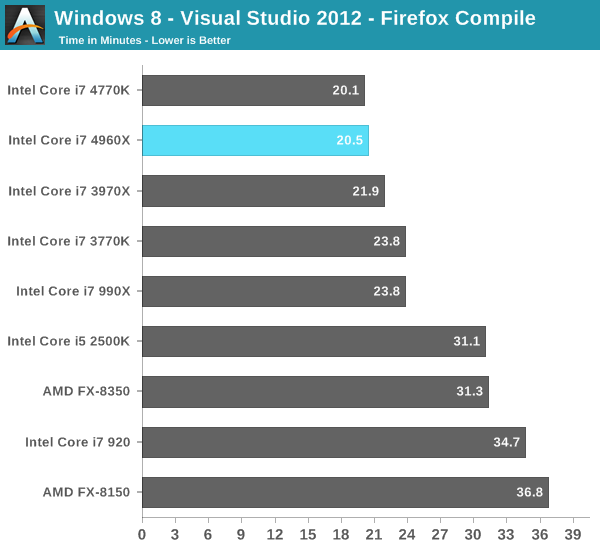
It's clear that IVB-E holds the advantage over Haswell when faced with heavily threaded workloads, but what about those workloads that are a good mix of both light and heavily threaded tasks? A medium-threaded workload if you will. It turns out our Firefox compile test is just that. Haswell's architectural improvements seem to do wonders for this test (under OS X as well), giving the 4770K a 16% lower compile time than Ivy Bridge. IVB-E on the other hand throws more cores at the problem, effectively equaling Haswell's performance but not exceeding it. In this case, if the rest of your applications are better threaded/demand more cores then IVB-E is the right solution for you. If, however, building Visual Studio projects is the most thread heavy thing you do then Haswell is a better option.
Photoshop
To measure performance under Photoshop CS4 we turn to the Retouch Artists’ Speed Test. The test does basic photo editing; there are a couple of color space conversions, many layer creations, color curve adjustment, image and canvas size adjustment, unsharp mask, and finally a gaussian blur performed on the entire image.
Time is reported in seconds and the lower numbers mean better performance. The test is multithreaded.
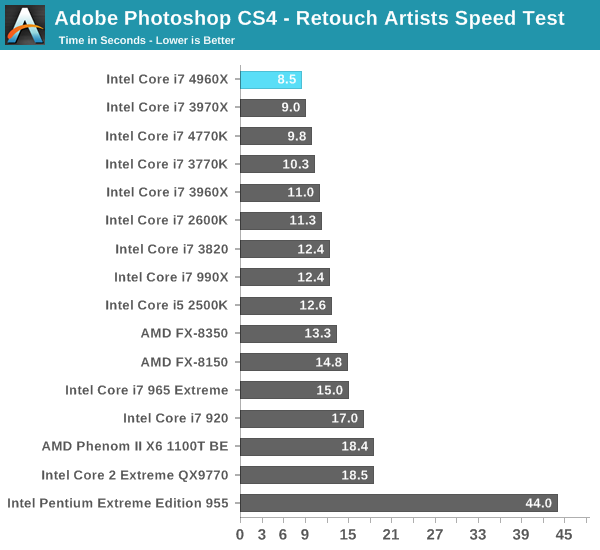
Our Photoshop test provides another example of an application with both lightly and heavily threaded behaviors. In this case, our Photoshop test favors the latter as the 4960X manages a 13% performance advantage over the 4770K. Once again the IVB-E advantage over SNB-E is around 5%.
File Compression/Decompression
The 7-zip benchmark is a CPU bound multithreaded integer workload that looks at 7-zip compression/decompression algorithms where the IO subsystem is removed from the equation:
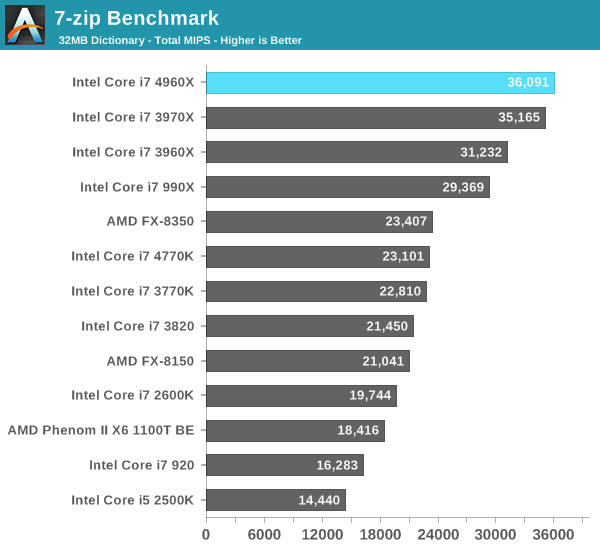
In its biggest advantage so far, the 4960X outperforms the 4770K by 56% in the 7-zip test. The IVB-E performance advantage compared to SNB-E shrinks to under 3% here. Heavily threaded integer workloads are also well suited for AMD's FX architecture. Here the FX-8350 is able to equal Haswell's performance.
Next up is our old Par2 test. Par2 is an application used for reconstructing downloaded archives. It can generate parity data from a given archive and later use it to recover the archive. Chuchusoft took the source code of par2cmdline 0.4 and parallelized it using Intel’s Threading Building Blocks 2.1. The result is a version of par2cmdline that can spawn multiple threads to repair par2 archives. For this test we took a 708MB archive, corrupted nearly 60MB of it, and used the multithreaded par2cmdline to recover it. The scores reported are the repair and recover time in seconds.
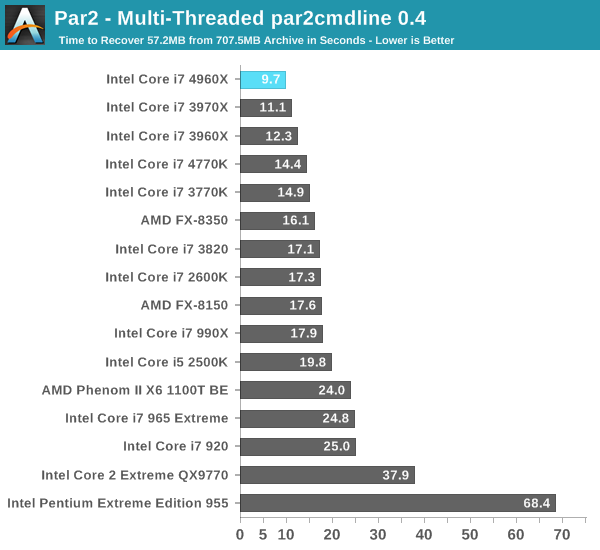
Here's another heavily threaded workload that does very well on the 4960X. We also see a rare situation where IVB-E increases performance over SNB-E by more than 10%.
Excel - Heavy Math
In our final CPU centric test we're running a monte carlo simulation on a large Excel spreadsheet. The process is well threaded.
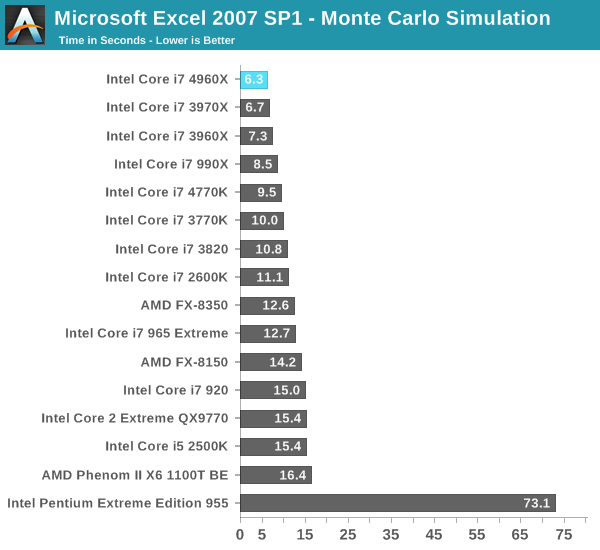
With 50% more cores, the 4960X delivers 33% better performance than the 4770K. If running multithreaded math workloads is up your alley, there's no alternative to the 6-core extreme edition parts.










120 Comments
View All Comments
Rick83 - Tuesday, September 3, 2013 - link
If you really want that number of cores, Ivy Bridge E5/E7 Xeons are going to deliver that, in the 150W power envelope. This is useful in the server market, but will only sell in homeopathic quantities in the desktop market. Still, you should be able to find them in retail around Christmas. Knock yourself out!Really IB-E is a free product for Intel, which is the only reason it made it to market at all. They need the 6-core dies for the medium density servers anyway, which is where they actually make sense over SB-Xeons, due to the smaller power envelope/higher efficiency. The investment to turn that core into a consumer product on an existing platform is almost zero, short of a small marketing budget, and possibly a tiny bit of (re-)validation.
This was never a product designed for the enthusiast market, and is being shoe-horned into that position. Due to the smaller die Intel can probably make better margin over SB-E, which is the only reason to introduce this product in the sector anyway, and possibly to get some brand awareness going with the launch of a new flagship.
From an economical point of view it makes no sense for Intel to have an actual enthusiast platform. Haswell refresh will be unlikely to bring more cores either (and without the extra I/O they would be a bit hobbled, I imagine), so possibly with Skylake there will be a 6-core upper mainstream solution. Still unlikely from an economical point of view, as Intel would probably prefer sticking to two dies, and going 6/4 may not be economical, whereas selling 6-core CPUs as quads (as they do with 48xx) doesn't work that well in the part of the market that generates reasonable volume.
f0d - Tuesday, September 3, 2013 - link
the problem with xeon is that you cant overclock them so my 5ghz SBE would be close to as good as a 8/10 core xeoni dont really care about why intel are not releasing high core count cpu's i just know i want them at a decent price ($1k and under) and overclockable - these 6 core ones just dont make the cut anymore
i just hate the direction cpu's are going with low power low core count highly integrated everythiing, 5 years ago i was dreaming of 8 core cpu's being standard about now but we still have 4 (6 with sbe) core cpu's as standard which blows and per core performance hasnt really changed much going from sandy bridge to haswell
i dont care about power and heat just give me the performance i want to encode highest quality handbrake movies in less than 24 hours.!!
ShieTar - Tuesday, September 3, 2013 - link
"All" you want is Intel to invest a massive development effort in order to produce for the first time an overclocking CPU with a TDP of around 200W, with silicone for which their business customers would pay 2k$ to 3k$, and sell it to you and the other 500 people in your niche for less than 1k$?Intel already offer you a solution if you need more processing power than the enthusiast solution gives you: 2 socket workstation boards, 4 socket server boards, 60-core co-processor cards.
f0d - Tuesday, September 3, 2013 - link
2 socket is inefficient for my workloadsthey could just release a xeon that is unlocked and let me do what i want with it - its not like the workstation/server guys would overclock so its not like intel would be losing any money
no development needed
2-3k? i can already buy 8 core SBE for 1k - why not let me oc that?
wallysb01 - Tuesday, September 3, 2013 - link
Many would overclock when Intel is charging hundreds of dollars for just small GHz bumps. You won't seem the academic or large corporation clusters doing it, but the small businesses with just a handful of workstations? They might.Look at the 2660 v2 2.2GHz at $1590 and the 2680 v2 2.8GHz at $1943. That's $353 for 600MHz. On a dual processor system its $700, then you have to pay the markups from those actually selling the computers (ie Dell/HP), which takes $700 to $1000 or more. One small little tweak and you're saving yourself $1000, while not stressing the system all that much (assuming you don't go crazy and try to get 3.5GHz from that 2.2GHz base chip).
mapesdhs - Wednesday, September 4, 2013 - link
The catch though is that the mbds used for these systems don't have
BIOS setups which support oc'ing, and the people who use them aren't
generally experienced in such things. I know someone at a larger movie
company who said it'd be neat to be able to experiment with this,
especially an unlocked XEON, but in reality the pressures of time, the
scale of the budgets involved, the large number of systems used for
renderfarms, the OS management required, etc., all these issues mean
it's easier to just buy off the shelf units and scale as required (the
renderfarm at the company I'm thinking of has more than 7000 cores
total, mostly based on Dell blade servers) and management isn't that
interested in doing anything different or innovative/risky. It's easy
to think a smaller company might be more likely to try such a thing,
but in reality for a smaller company it would be a much larger
financial risk to do so. Bigger companies could afford to try it, but
aren't geared up for such ideas.
Btw, oc'ing a XEON is viable with single-socket mbds that happen to
support them and have chipsets which don't rely on the CPU multiplier
for oc'ing, eg. an X5570 on an Asrock X58 Extreme6 works ok (I have
one); the chip advantage is a higher TDP and 50% faster QPI compared to
a clock-comparable i7 950.
Sadly, other companies often don't bother supporting XEONs anyway;
Gigabyte does on some of its boards (X58A-UD3R is a good example) but
ASUS tends not to.
Some have posted about core efficiency and they're correct; I have a
Dell T7500 with two X5570s, but my oc'd 3930K beats it for highly
threaded tasks such as CB 11.5, and it's about 2X faster for single-
threaded ops. The 3930K's faster RAM probably helps aswell (64GB
DDR3/2400, vs. only DDR3/1333 in the Dell which one can't change).
Someone commented about Intel releasing an unlocked XEON. Of course
they could, but they won't because they don't need to, and biz users
wouldn't really care, it's not what they want, and note that power
efficiency is very important for big server setups, something of which
oc'ing can of course make utterly ruin. :D Someone said who cares about
power guzzling when it comes to enthusiast builds, and that's true, but
when it comes to XEONs the main target market does care, so again Intel
has no incentive to bother releasing an unlocked XEON.
I agree with the poster who said 40 PCIe lanes isn't ridiculous. We had
such provision with X58, so if anything for a top-end platform only 40
lanes isn't that impressive IMO. Far worse is the continued limit of
just 2 SATA3 ports; that really is a pain, because the 3rd party
controllers are generally awful. The Asrock X79 Extreme11 solved this
to some extent by offering onboard SAS, but they kinda crippled it by
not having any cache RAM as part of the built-in SAS chip.
Ian.
wallysb01 - Wednesday, September 4, 2013 - link
"It's easy to think a smaller company might be more likely to try such a thing, but in reality for a smaller company it would be a much larger financial risk to do so. Bigger companies could afford to try it, but aren't geared up for such ideas.Btw, oc'ing a XEON is viable with single-socket mbds that happen to support them and have chipsets which don't rely on the CPU multiplier for oc'ing, eg. an X5570 on an Asrock X58 xtreme6 works ok (I have one); the chip advantage is a higher TDP and 50% faster QPI compared to a clock-comparable i7 950."
These two statements work against eachother. If OC a SP xeon is relatively easy, only if supported, there isn't much reason a DP xeon set up couldn't be OCed within reason without much effort.
I'm not going to say this would be a common thing, but the small shops run by someone with a "tinkerer" mind set towards computing would certainly be interested in attempting to get that extra 10-20% performance, which Intel would change another $1000 or more for, but get it for free.
psyq321 - Thursday, September 5, 2013 - link
Z9PE-D8 WS has decent overclocking options (not like their consumer X79 boards, but not bad either).However, apart from a small BCLK bump, this is useless as SNB-EP and IVB-EP Xeons are locked.
The best I can do with dual Xeon 2697 v2 is ~3150 MHz (I might be able to go a bit further but I did not bother) for all-core turbo.
Even if Intel ignores the business reasons NOT to allow Xeon overclocking (to force high-performance-trading people to buy more expensive Xeons as they showed willingness to overclock and, so, potentially cannibalize market for more expensive EX parts) technically this would be a huge challenge.
Why? Well, 12-core Xeon 2697 power-usage would literally explode if you allow running this on 4+ GHz and with voltages normally seen in overclocking world. I am sure the power draw of the single part would be more than 300W, so 600W for a dual-socket board.
This is not unheard of (after all, high-end GPUs can draw comparable power) - however, this would mandate significantly higher specs for the motherboard components and put people in actual danger of fires by using inadequate components.
Maybe when Intel moves to Haswell E/EP - when the voltage regulation becomes CPUs's business, maybe they can find a way to allow overclocking of such huge CPUs after passing lots of checks. Otherwise, Intel runs huge risk of being sued for causing fires.
mapesdhs - Sunday, August 13, 2017 - link
Four years later, who could have imagined we'd end up with Threadripper, and the mess Intel is now in? Funny old world. :Dstephenbrooks - Monday, September 23, 2013 - link
--[i just hate the direction cpu's are going with low power low core count highly integrated everythiing, 5 years ago i was dreaming of 8 core cpu's being standard about now but we still have 4]--So I got an AMD FX8350, that's 8 cores and 4GHz before turbo. Quite a bit cheaper than Intel's too.
OK, obviously AMD gets less operations per clock and the 8 cores only have 4 "real" FPUs between them but I wanted 8 cores to test scaling of computer programs on without breaking the bank.